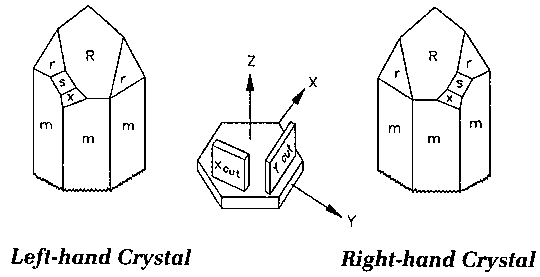|

As shown in the above schematic drawing, alpha-quartz crystal has a single axis
of three-fold symmetry (trigonal axis), and it has three axes of two-fold
symmetry (digonal axes) that is perpendicular to that trigonal axis. The digonal
axes are spaced 120° apart and are polar axes, that
is, a definite sense can be assigned to them. The presence of polar axes implies
the lack of a center symmetry and is necessary condition for the existence of
the piezoelectric effect. The digonal axes are also known as the electric axes
of quartz (x-, y-axis). In crystal with fully developed natural faces, the two ends of each
polar axis can be differentiated by the presence or absence of the S and X faces. When pressure is applied in the direction of the electric axis, a
negative charge is developed at that end of the axis modified by these faces.
The trigonal axis, also known as the optic axis (z axis), is not polar, since the
presence of digonal axes normal to it implies that the two ends of the trigonal
axis are equivalent. Thus no piezoelectric polarization can be produced along
optic axis. In
the rectangular coordinate systems, the z-axis is parallel to the m prism faces.
A plate of quartz cut with its major surface perpendicular to the x-axis is
called an X-cut plate. Rotating the cut 90 degrees about the z-axis gives a
Y-cut plate with the y-axis now perpendicular to the major surface. Since a
quartz crystal has six prism faces, three choices exist for the x- and y-axis.
The selection is arbitrary; each behaves identically.
Quartz is an optically active material. When a beam of plane-polarized light
is transmitted along the optic axis, a rotation of the plane of polarization
occurs, and the amount the rotation depends on the distance traversed in the
material. The sense of the rotation can be used to differentiate between the two
naturally occurring forms of alpha-quartz known as left quartz and right quartz.
In left quartz the plane of polarization rotates anti-clockwise when seen by an
observer looking towards the source of light, and in right quartz it rotates
clockwise. Most cultured quartz produced is right quartz, whereas in natural
left- and right- quartz are about equally distributed. Either form can equally
well be used in the manufacture of resonators, but material in which left and
right forms are mixed, which is called optically twinned material, can not be
used. On the other hand, electrically twinned material is all of the same hand,
but contains regions where the sense of the electric axis is reversed, thus
reducing the overall piezoelectric effect. Such material is also not suitable
for resonator application. The presence of twinning and other defects in natural
quartz crystal is the major reason for the shortage of suitable natural
material, and the absence of significant twinning in cultured quartz constitutes
one of its main advantages. When alpha-quartz is heated to above 573°
C, the crystalline form changes to that of beta-quartz, which has hexagonal
rather than trigonal symmetry. On cooling down through 573°
C, the material reverts to alpha-quartz, but in general will be found to
electrically twinned. By the same token, the application of large thermal or
mechanical stresses can induce twinning, so it is necessary in resonator
processing to avoid any such thermal or mechanical shocks.
After being removed from an autoclave in which they were produced, cultured
quartz crystals are converted, by grinding, into so-called lumbered bars. These
are long, rectangular bars, suitable for subsequent cutting into wafers for
resonators. Lumbered bars are typically 6 to 8 inch long, but usable length is
about 5 to 6 inch because material near the ends is unusable. Longer bars can be
grown, but these require longer seeds, the cost of which increases rapidly with
length. Height of lumbered bars generally is approximately twice the width
because two wafers are normally cut from each slice. Numerous standard-sized
lumbered bar are available, and quartz can also be grown and ground to specified
dimensions.
|


